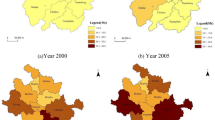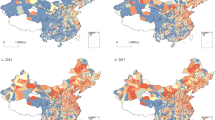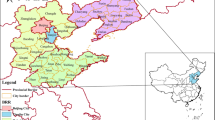Abstract
Zhejiang Province is a “demonstration area for high-quality development and construction of common prosperity” in China. Moreover, the county is the basic unit and power source for the economic development of Zhejiang Province. Therefore, the research on the spatial–temporal characteristics and influencing factors of county-level carbon emissions is of great significance for Zhejiang Province to achieve the strategic goal of carbon peak and carbon neutrality. Based on the carbon emissions and socio-economic data of 62 counties in Zhejiang Province from 2014 to 2020, the spatial dependence and agglomeration of county-level carbon emissions are analyzed through the spatial autocorrelation test and local spatial autocorrelation test respectively. According to the spatial–temporal characteristics of county-level carbon emissions revealed by the index of Moran’s I and local Moran’s I, the spatial error STIRPAT model is used to study the influencing factors of county-level carbon emissions in Zhejiang Province, China. The main results are as follows: (1) The total amount of county-level carbon emissions of 62 counties fluctuates from 259.69 to 326.28 million tons and shows a growth trend. (2) Moran’s I index is between 0.369 and 0.399. The county-level carbon emissions have a significant spatial correlation, and the spatial agglomeration trend is relatively stable, which is consistent with the hypothesis of the geographical polarization effect. (3) High-high agglomeration counties are concentrated in the northeast of Zhejiang Province, while low-low agglomeration counties are mainly in the southwest. (4) The relationship between county per capita GDP and carbon emissions has not been “decoupled,” because when other variables remain unchanged, the county’s total carbon emissions will increase by 2.866% for every 1% increase in the county’s per capita GDP; the increase of the proportion of secondary industry contributes to the decline of carbon emissions, and the low-carbon effect brought by large-scale industrial development as well as scientific and technological innovation has not yet appeared. (5) The estimate of the spatial coefficient λ was 0.324, which illustrates that the carbon emission of a single county is positively affected by the carbon emission of the neighboring counties, and other socio-economic factors affecting carbon emission among counties also have a spatial correlation. Therefore, the policy of realizing regional coordinated development as well as the carbon peaking and carbon neutrality goals should not only focus on industrial layout, but also take a dynamic and comprehensive consideration from a spatial perspective.




Similar content being viewed by others
Data availability
The datasets used and/or analyzed during the current study are available from the corresponding author on reasonable request.
Notes
The 14th Five-Year Plan for Climate Change in Zhejiang Province, Development and Reform Commission of Zhejiang Province, http://fzggw.zj.gov.cn/art/2021/6/16/art_1229123366_2302792.html, 2021–06-16.
People’s Republic of China, Second Biennial Update Report on Climate Change (December 2018) at p. 16.
References
Ang WB (2005) The LMDI approach to decomposition analysis: a practical guide. Energy Policy 33(7):867–871
Anselin L, Moreno R (2003) Properties of tests for spatial error components. Reg Sci Urban Econ 33:595–618
Balezentis T, Siksnelyte BI, Ramanauske N, Streimikiene D, Coluccia B (2022) Disentangling the sources of dynamics in the agricultural output of the BRIICS and EU countries: the ecological footprint perspective with Shapley value decomposition. J Clean Prod 346(20):131198
Canas A, Ferrao P, Conceicao PA (2003) New Environmental Kuznets Curve? Relationship between direct material input and Income per capital: evidence from industrialized countries. Ecol Econ 46(2):217–229
Carmona R, Dayanıklı G, Laurière M (2022) Mean field models to regulate carbon emissions in electricity production. Dynamic Games and Applications
Chen JD, Gao M, Cheng SL et al (2020) County-level CO2 emissions and sequestration in China during 1997–2017. Scientific Data 7(391): https://doi.org/10.1038/s41597-020-00736-3.
Diakoulaki D, Mandaraka M (2007) Decomposition analysis for assessing the progress in decoupling industrial growth from CO2 emissions in the EU manufacturing sector. Energy Economics 29(4):636–664
Dietz T, Rosa EA (1997) Effects of population and affluence on CO2 emission. Natl Acad Sci USA 94(1):175–179
Doll C N H, Muller J P, Elvidge CD (2000) Night-time imagery as a tool for global mapping of socioeconomic parameters and greenhouse gas emissions. AMBIO: A Journal of the Human Environment 29(3):157–162
Du X, Shen L, Wong SW, Meng C, Yang Z (2021) Night-time light data based decoupling relationship analysis between economic growth and carbon emission in 289 Chinese cities. Sustain Cities Soc 73:103119
Ehrlich PR, Holdren JP (1971) Impact of population growth. Science 171(3977):1212–1217
Focacci A (2003) Empirical evidence in the analysis of the environmental and energy policies of a series of industrialized nations during the period 1960–1997, using widely employed macroeconomic indicators. Energy Policy 31(4):333–352
Grossman GM, Krueger AB (1995) Economic growth and the environment. NBER Working Papers 110(2):353–377
Kaya Y (1989) Impact of carbon dioxide emission control on GNP growth: Interpretation of proposed scenarios [R]. Intergovernmental Panel on Climate Change (IPCC), Paris
Liao M, Zhang Z, Jia J, Xiong J, Han M (2022) Mapping China’s photovoltaic power geographies: spatial-temporal evolution, provincial competition and low-carbon transition. Renew Energy
Liu D, Xiao B (2018) Can China achieve its carbon emission peaking? A scenario analysis based on STIRPAT and system dynamics model. Ecol Ind 93:647–657
Liu Y, Xiao HW, Zhang N (2016) Industrial carbon emissions of China’s regions: a spatial econometric analysis. Sustainability 8(3):210
Lundquist S (2021) Explaining events of strong decoupling from CO2 and NOx emissions in the OECD 1994–2016. Sci Total Environ 793:148390
Moreau V, Vuille F (2018) Decoupling energy use and economic growth: counter evidence from structural effects and embodied energy in trade. Appl Energy 215:54–62
Roberts JT, Grimes PE (1997) Carbon intensity and economic development 1962–1991: a brief exploration of the environmental Kuznets curve. World Dev 25(2):191–198
Shi B, Xiang W, Bai X, Wang Y, Geng G, Zheng J (2022) District level decoupling analysis of energy-related carbon dioxide emissions from economic growth in Beijing China. Energy Reports 8:2045–2051
Su K, Lee CM (2020) When will China achieve its carbon emission peak? A scenario analysis based on optimal control and the STIRPAT model. Ecol Ind 112:106138
Tenaw D, Hawitibo LA (2021) Carbon decoupling and economic growth in Africa: evidence from production and consumption-based carbon emissions. Resources, Environment and Sustainability 6:100040
Wang J, Xu C (2017) Geographic detector: principle and outlook. J Geogr 2(1):116–134
Wang P, Wu W, Zhu B, Wei Y (2013) Examining the impact factors of energy-related CO2 emissions using the STIRPAT model in Guangdong Province China. Appl Energy 106(11):65–71
Wu J, Bo L (2022) Spatio-temporal evolutionary characteristics of carbon emissions and carbon sinks of marine industry in China and their time-dependent models. Mar Policy 135:104879
Xu SC, He ZX, Yin Long R (2014) Factors that influence carbon emissions due to energy consumption in China: Decomposition analysis using LMDI. Appl Energy 127(15):182–193
Xu W, Xie Y, Ji L (2022) Spatial-temporal evolution and driving forces of provincial carbon footprints in China: An integrated EE-MRIO and WA-SDA approach. Ecol Eng 106543
York R, Rosa E, Dietz T (2003) STIRPAT, IPAT and ImPACT: analytic tools for unpacking the driving forces of environmental impacts. Ecol Econ 46(3):351–365
Zhang L, Kou C, Zheng J, Li Y (2018) Decoupling analysis of CO2 emissions in transportation sector from economic growth during 1995–2015 for six cities in Hebei, China. Sustainability 10(11):4149
Zhang H, Jin G, Zhang Z (2021) Coupling system of carbon emission and social economy: a review. Technological Forecasting and Social Change 167(C):120730
Funding
This manuscript was supported by the National Natural Science Foundation of China (Grant No. 71473230) (Grant No. 71803180), the Philosophy and Social Sciences Planning Project of the Ministry of Education in China (Grant No. 18YJCZH140) (Grant No. 17YJCZH048), and the National Philosophy and Social Sciences Foundation ( Grant No. 17BGL127).
Author information
Authors and Affiliations
Contributions
Conceptualization and methodology: HQ and XS. Data collection and statistical analysis: XS and FL. Visualization: XS and FL. Writing — original draft preparation: HQ and XS. Writing — review and editing: FL and ML.
Corresponding author
Ethics declarations
Ethics approval and consent to participate
Not applicable.
Consent for publication
All authors read and approved the final manuscript.
Competing interests
The authors declare no competing interests.
Additional information
Responsible Editor: Ilhan Ozturk
Publisher's note
Springer Nature remains neutral with regard to jurisdictional claims in published maps and institutional affiliations.
Rights and permissions
Springer Nature or its licensor holds exclusive rights to this article under a publishing agreement with the author(s) or other rightsholder(s); author self-archiving of the accepted manuscript version of this article is solely governed by the terms of such publishing agreement and applicable law.
About this article
Cite this article
Qi, H., Shen, X., Long, F. et al. Spatial–temporal characteristics and influencing factors of county-level carbon emissions in Zhejiang Province, China. Environ Sci Pollut Res 30, 10136–10148 (2023). https://doi.org/10.1007/s11356-022-22790-7
Received:
Accepted:
Published:
Issue Date:
DOI: https://doi.org/10.1007/s11356-022-22790-7




